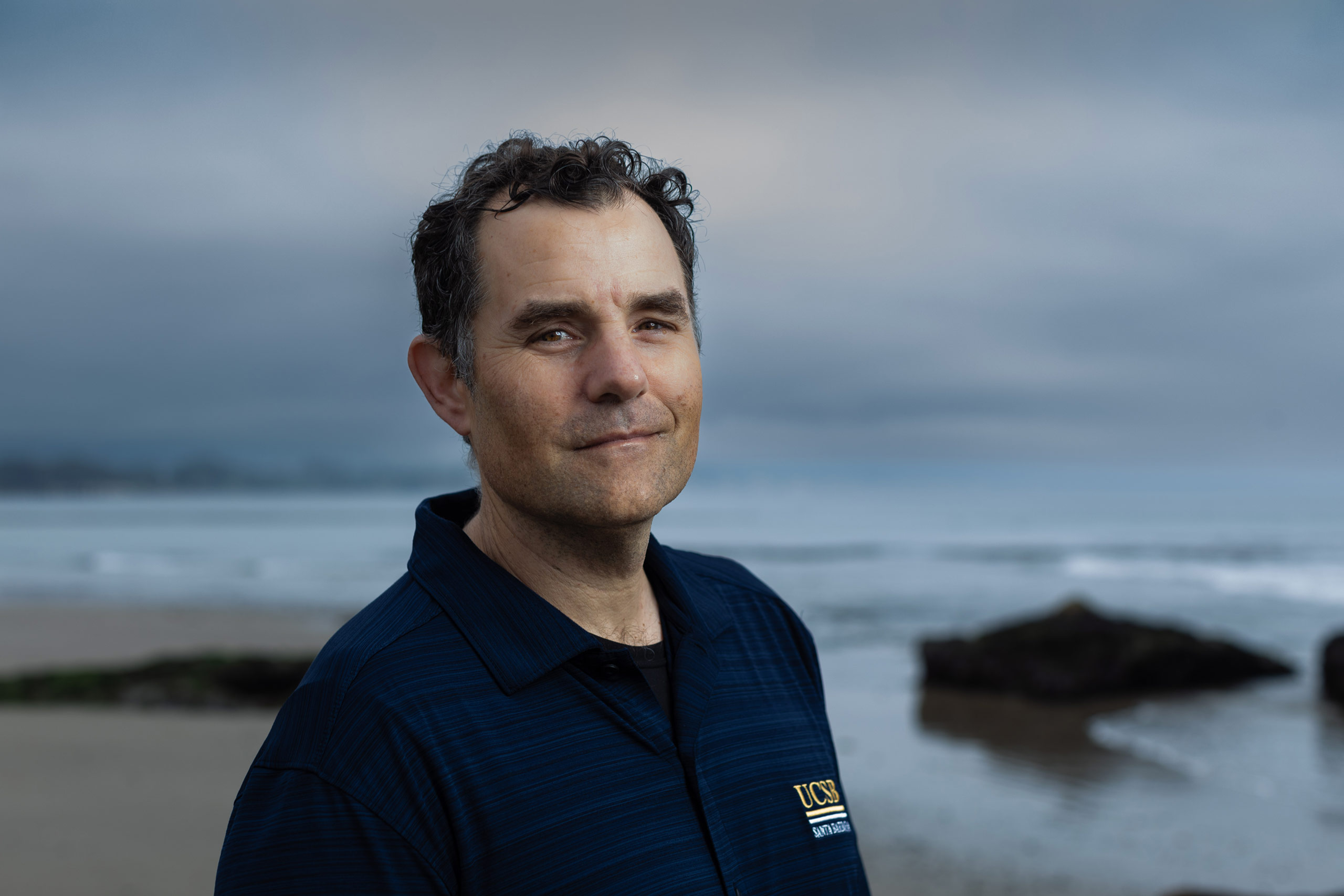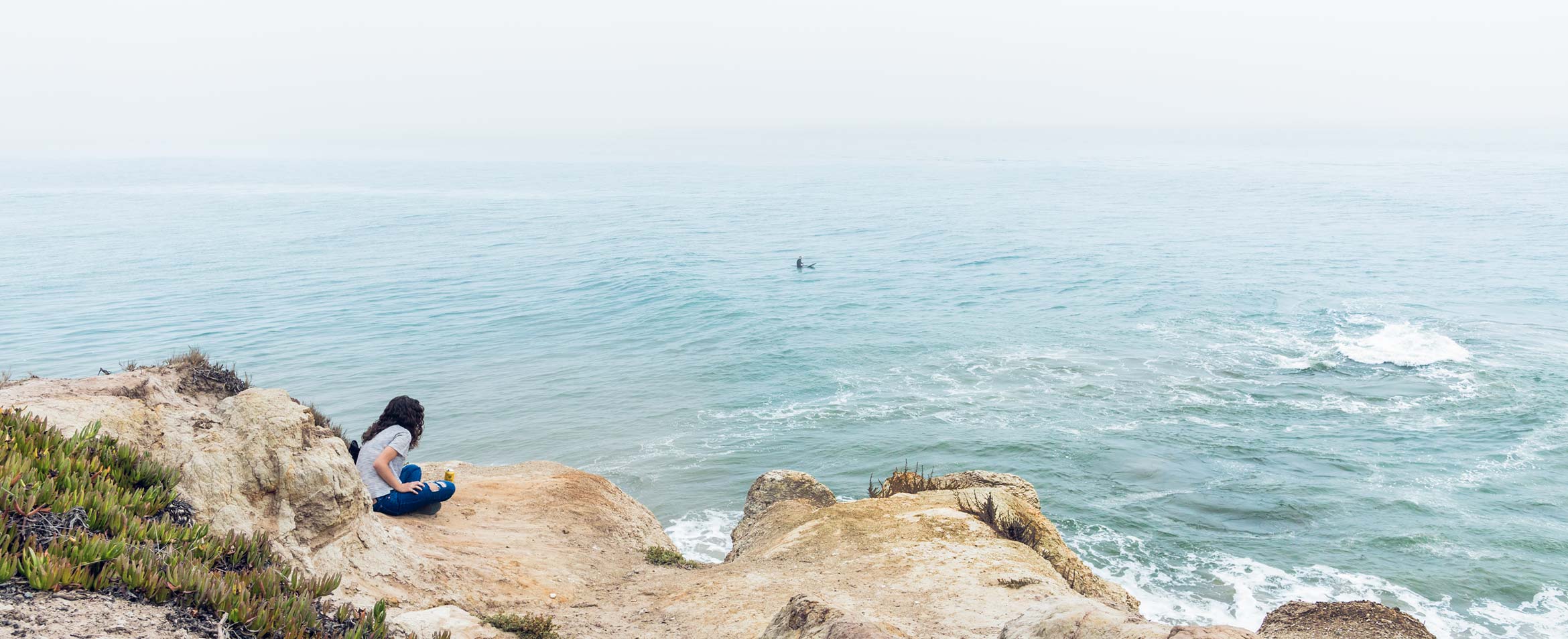
Discoveries from Disasters
Professor David Valentine at Campus Point, UC Santa Barbara
PHOTO: MATT PERKO
Discoveries from Disasters
A conversation with oceanographer David Valentine
DURING A RESEARCH VOYAGE IN 2011, Professor David Valentine discovered massive amounts of DDT dumped off the coast of Los Angeles. For several years he worked to publicize the issue, attracting attention and funding to study the contaminants and the risks they pose to society and the environment. Valentine is familiar with ecological disasters, and with media coverage — he responded to the Deepwater Horizon spill in 2010. But his research is far more comprehensive. He takes us behind the headlines in this Q&A about his work and professional trajectory.
Your lab’s work is pretty eclectic — a bit of biology, some oceanography, organic chemistry. What would you say unites your research?
I have struggled for years to answer that question. And I think one of the main uniting factors is that my research involves interactions of chemicals and microorganisms, their metabolisms and how that interfaces with the world around them.
Talk about how you integrate your more applied research, like oil spills and science policy, with more fundamental topics, like microbial ecosystems and biogeochemistry.
I sort of always hoped I could do something that could make a difference. Eventually, I developed expertise that then became important.
I started my Ph.D. studying how hydrogen and methane — gases that can both be produced and consumed by microbes — behave in nature. I knew that methane was going to become important because of its impacts on climate, and that hydrogen might become important if we ever actually moved toward a hydrogen economy.
After my Ph.D., I came to UCSB in part because we have all this methane that’s emanating from the sea floor, and it was really an ideal natural lab for me.
People were interested in methane, but oil, seeps and other natural gases were not a high-profile topic at the time.
Then in 2010, the Deepwater Horizon exploded and sank, and this incredible flow of oil came gushing out into the deep Gulf of Mexico, live-streamed to the world, including a volume counter.
My lab members and I had been thinking quite deeply about how microbes respond to petrochemicals entering the ocean, and everybody in the country suddenly cared about it.
So I pivoted my research and approached my funders at the National Science Foundation and Department of Energy and explained to them how the research they’d been funding could be applied to understand what was happening in the deep Gulf of Mexico. They agreed, provided supplements and rapid support, and within weeks I was on a flight to Mississippi.
How did this affect your basic science research?
I realized that, with all of the resources that come for these events, I could do hypothesis-driven research. I could figure things out that people were genuinely interested in — members of the public and reporters, not just scientists. It was an opportunity to leverage discovery from these disasters. So that became my lab tagline: Discoveries from Disasters.
And events like Deepwater Horizon generate a much larger response than you could create in the lab.
I often call that particular one a forbidden experiment that BP ran with no replication.
Publicizing the DDT discovery was a very conscious decision.
The idea was it’s going to be five years, but two years after our initial observations, things were going slow. The government was not interested in supporting the research. And so I decided to focus on that.
The imagery we had collected was evocative, but if we released it as is, the narrative would have exploded uncontrollably, totally unconstrained. It would have just become another sensation that had no backing. I needed to do the science to understand what I was really looking at and how much of a problem it really was. That’s why I didn’t release any of that imagery for another six years.
Has it gotten to where you want yet?
My argument has been that we really need to define the scope of the problem. And we are maybe on that path now. There are so many scientific unknowns.
We’ve made advances; we’re still trying to understand what the long-term fate looks like and the potential for all of this material that’s spilled to get back into the biosphere. And this is just one of 14 different sites off the coast of California that are going to have similar issues.
So this is part of a larger pattern, then?
Taking a 10,000-foot view, we probably need a national program to actually start looking at this to figure out where all this stuff is, and what are its impacts. There was military, municipal, industrial, radioactive dumping, the full suite. And it’s really such a hodgepodge of terrible records that I think there needs to be some renewed coordinated effort, with a modern lens and the application of modern technologies.
What aspects of your career so far are you most proud of, and why?
I would say mentoring students — graduate and undergraduate — and getting them excited about conducting research. This is what really drew me into the College of Creative Studies, getting students who are already research-curious and providing them an opportunity to explore that interest and develop it into a real passion. This goes to one of my long-time lab mottos: People first, then science, then funding.



